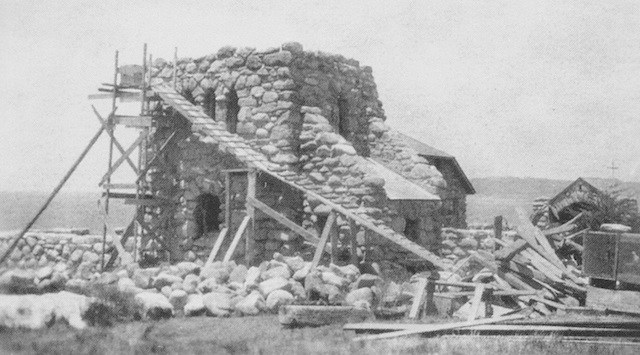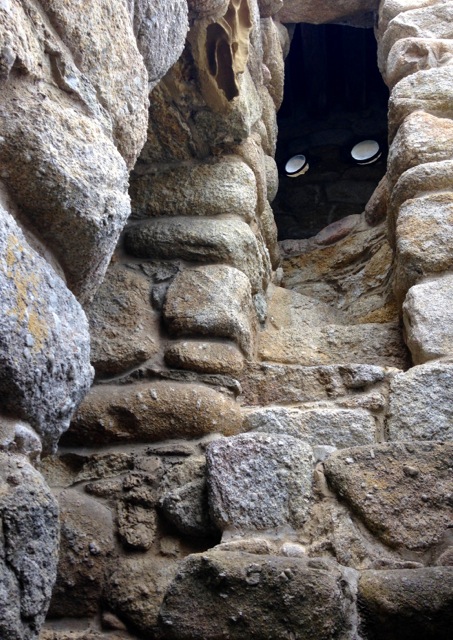The next building project was a big one: a tower. Una loved Irish round towers, and she also loved William Butler Yeats. Yeats had restored a tower for his wife in the west of Ireland, so Robin set about building Una a tower.
As Jeffers built the tower, he was presented with mental challenges that he hadn’t faced as a student of letters. When he needed a rock of a particular shape, he would have to carry it up to 40 feet up to try it out, so he had better think hard about the shape of a stone. Perhaps the art of fitting stones together is not entirely unlike the art of fitting words together. Perhaps working with stone taught Jeffers the temperament of stone and caused him to speak—and write—with less flowery language.

Hawk Tower and ramp (Tor House Foundation)
When the tower was finally completed, it had four levels: one for Una, one for the twins, and the top two for Jeffers himself. The lowest level, a rough, split-level layout with a small, ineffective fireplace, a dungeon of sorts, and a secret passage to the second level, would be employed as a play area for the twins. The second level was by far the most luxurious, appointed with a better fireplace, mahogany paneling, an alcove with an oriel window, and gothic arches. It was obviously for Una, marked with a unicorn (Una’s totem) cast in sandstone over the door, and Una would make good use of it as her retreat.
The roof platform and turret were the poet’s domain, given the mark of a hawk (Robin’s totem) cast in sandstone over the door. Jeffers would name the tower itself “Hawk Tower.” This was a retreat more fitting for Jeffers, open as it would be to the elements, the sea, and the stars. He would visit the turret every night before bed, as well as employ it as a lookout during World War II.
A couple years into Jeffers’ work on the tower, a new poet appeared from scaffolding and stone, like a butterfly from her chrysalis, or rather, as though a butterfly had folded herself into her chrysalis and reappeared years later as a hawk.
Jeffers began to write again, and what he was writing was nothing like what he had been writing before.
When the tower was finally complete, Jeffers had also completed an unprecedented long narrative poem named “Tamar,” along with a new breed of stark thought-lyrics. He knew that he had finally created something worth while, but he failed to find a publisher for it.
Jeffers resorted to paying for a print run with money from his inheritance. He kept a crate loaded with copies of Tamar and Other Poems in the attic of Tor House for a year before anyone of any consequence noticed it.
He continued to work with stone, this time building an addition to the house, and he continued to write remarkable poems such as Boats in a Fog (1925), wherein Jeffers speaks of discovering beauty in unexpected places:
it is bitter earnestness That makes beauty; the mind Knows, grown adult.
Jeffers was certainly influenced by a variety of people and events. The War, his education and his father, Una’s eyes and ears on the world, and the beauty of the Central Coast. All that considered, nothing can be shown to have breathed life into his poetry so much as did the sea-granite of Carmel Point. Robinson Jeffers had been handsome as a young man at age 32, when his portrait was painted in 1919, but he looked little like the stonemason of the Jo Davidson sculpture eleven years later. We often hear how people grow to resemble their spouses, or even their pets. Is it possible that Jeffers’s affair with the sea-granite may have changed his appearance to more closely resemble stone? —Next—>

